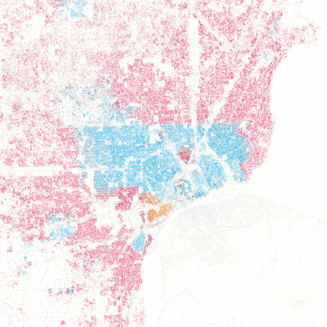Demographic history of Detroit

From the early nineteenth century up to the Great Depression, the population of Detroit grew at an extremely rapid pace, increasing by more than 1,000 times between 1820 and 1930.[1] This massive population increase was partially due to the auto industry expansion during the early twentieth century.[2]
History
Detroit was founded in 1701 with a population of 100 French soldiers, farmers and merchants. The first women arrived the next year. Indian settlements of various tribes around the fort soon far outnumbered the French. Detroit grew into the most important city between Montreal and New Orleans. Its European population was 800 people in 1765, with most or all of the Indian having long before left.[3] By 1773, the population of Detroit was 1,400. By 1778, its population was up to 2,144 and the third largest city in the Province of Quebec.[4]
The city became a magnet for immigrants, especially before World War I, when over one-third of its population was consistently composed of immigrants.[5] From at least 1880 to the 1980s, the greatest number of immigrants living in Wayne County, Michigan (where Detroit is located) were from Central and Eastern Europe.[6] After the passage of laws restricting immigration to the U.S. in the 1920s and the later internal migration out of Detroit, the percentage of immigrants among Detroit's total population consistently fell until 1990, by which point immigrants composed less than five percent of Detroit's total population.[5] By contrast, the enclave city of Hamtramck had 43% foreign-born in 2010; a bordering city, Dearborn, had 25%.
In 1943, Detroit's population had grown by 350,000 people since the beginning of World War II.[7] The booming defense industries brought in large numbers of people with high wages and very little available housing.[7] 50,000 blacks had recently arrived along with 300,000 whites, mostly from rural Appalachia and Southern States.[7] The population for the city peaked in 1950 and then decreased by about 60% by 2010 with migration to the suburbs.[1] Detroit was in the top ten most populous cities in the United States between 1910 and the 2000-2009 decade, and it was the fourth most populous city in the United States between 1920 and 1950.[8][9] Due to its population decrease between 2000 and 2010, the city became the 18th most populous city in the United States.[2]
The first and second Great Migrations of African Americans from the Southern United States between 1910 and 1980 increased Detroit's African American population by over 100 times.[1] The White population of the city peaked in 1950 and then steadily declined due to white flight, net outmigration through 2010.[1] The white population has fallen 95% between the 1950 and 2010 censuses.
The Hispanic population of Detroit rapidly increased after 1940, with the Hispanic population of Detroit being almost ten times higher in 2010 than it was in 1940.[1] Since the 1980s, the largest overseas immigrant groups in Wayne County have been from Asia and the Middle East.[6]
| Demographic history profile of Detroit, Michigan, Between 1820-2010[1][5][10] | ||||||||||||||||||||||||||||||||||||||||||||||||||||||||||||||||||||||||||||||||||||||||||||||||||||||||||||||||||||||||||||||||||||||||||||||||||||||||||||||||||||||||||||||||||||||||||||||||||||||||||||||||||||||||||||||||||||||||||||||||||||||||||||||||||||||||||||||||||||||||||||||||||||||||||||||||||||||||||||||||||||||||||||||||
|
See also
References
- ↑ 1.0 1.1 1.2 1.3 1.4 1.5 Gibson, Campbell; Kay Jung (February 2005). "Table 23. Michigan - Race and Hispanic Origin for Selected Large Cities and Other Places: Earliest Census to 1990". United States Census Bureau. Retrieved January 8, 2013.
- ↑ 2.0 2.1 Seelye, Katharine (March 22, 2011). "Detroit Census Confirms a Desertion Like No Other". The New York Times. Retrieved December 29, 2012
- ↑ French Ontario in the 17th and 18th centuries – Detroit. Archives of Ontario July 14, 2008. Retrieved July 23, 2008.
- ↑ Jacqueline Peterson, Jennifer S. H. Brown, Many roads to Red River (2001), p69
- ↑ 5.0 5.1 5.2 Gibson, Campbell; Kay Jung (February 2006). "Historical Census Statistics on the Foreign-Born Population of the United States: 1850-2000". United States Census Bureau. Retrieved January 21, 2013.
- ↑ 6.0 6.1 Bloch, Matthew; Gebeloff, Robert (March 10, 2009), "Immigration Explorer", The New York Times, retrieved January 21, 2013
- ↑ 7.0 7.1 7.2 Sitkoff, Harvard (Fall 1969). "The Detroit Race Riot of 1943". Michigan History 53: 183–206.
- ↑ Gibson, Campbell (June 1998). "Population of the 100 Largest Cities and Other Urban Places in the United States 1790 to 1990". U.S. Census Bureau Population Division. Retrieved December 29, 2012.
- ↑ County and City Data Book: 2000. United States Census Bureau. pp. 644–661.
- ↑ "Detroit (city), Michigan". State & County QuickFacts. United States Census Bureau. June 8, 2006. Retrieved January 21, 2013.